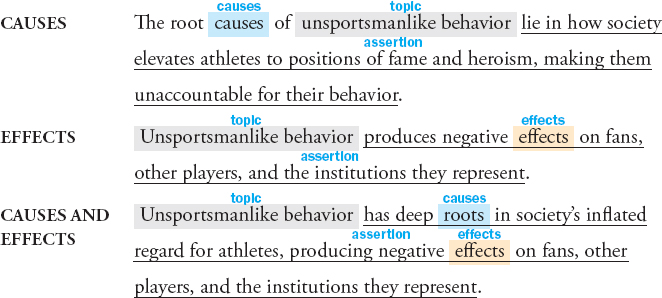CHARACTERISTICS OF CAUSE-AND-EFFECT ESSAYS
A successful causal analysis essay fully explains the causes or effects that are the focus of the essay’s thesis and presents those causes or effects in a logical order.
CAUSAL ANALYSIS MAY FOCUS ON CAUSES, EFFECTS, OR BOTH
Remember that causes are the reasons that something happened and effects are the results of the thing that happened. Some causes and effects are relatively easy to separate out.

But causal analysis can be complex when it deals with an event or phenomenon that has multiple causes, multiple effects, or both. For example, you probably chose the college you attend (one effect) for a number of reasons (multiple causes).

One cause may also have several effects. For instance, the decision to quit your part-time job (one cause) will have several results (multiple effects).

Related events or phenomena may have multiple causes and multiple effects. For instance, in urban areas, an increase in the number of police patrolling the street along with the formation of citizen watch groups (multiple causes) will result in less street crime and more small businesses moving into the neighborhood (multiple effects).

In some cases, a series of events forms a chain of consequences.

Once you clearly identify causes and effects, you can decide whether to focus on causes, effects, or both.
CAUSAL ANALYSIS INCLUDES A CLEAR THESIS STATEMENT
An effective thesis statement for a cause-and-effect essay does the following.
- It identifies the topic.
- It makes an assertion about that topic.
- It suggests whether the essay focuses on causes, effects, or both.

CAUSAL ANALYSIS IS LOGICALLY ORGANIZED
A good cause-and-effect essay is organized logically and systematically. You may present causes or effects in any logical order, but these are the most commonly used.
- Chronological order, the order in which causes or effects happened
Example: An essay about causes of rising college tuition costs might begin with reasons for tuition increases in the late 1990s and move chronologically to current increases.
- Most-to-least or least-to-most order
Example: An essay about increased immigration to the United States might begin with the most important causes and progress to less important causes.
CAUSAL ANALYSIS EXPLAINS EACH CAUSE OR EFFECT FULLY
A causal analysis essay should present each cause or effect in a detailed and understandable way. For most cause-and-effect essays, you will need to research your topic to find evidence that supports your thesis. For instance, in an essay about the effects on children of viewing violence on television, you might conduct research to locate facts or statistics that document changes in children’s behavior after watching violent programs or expert opinion supporting this claim.
You might use another pattern of development (such as illustrations, descriptions, or comparisons) to explain causes or effects. For example, an essay about why dishonesty and lying are common in social media may include reasons, but also give examples or narrate incidents of dishonesty, categorize the characteristics of the social media environment that make lying easy, or contrast face-to-face communication with online communication.
CAUSAL ANALYSIS MAY CHALLENGE READERS’ ASSUMPTIONS OR OFFER SURPRISING REASONS
Cause-and-effect essays that merely repeat commonplace causes or effects will discourage the audience from reading on. Engaging causal analyses, in contrast, surprise readers by challenging popular assumptions, offering surprising reasons, or including interesting evidence. For example, an essay on the effects of capital punishment might attempt to dispel the notion that it deters crime or it might surprise readers by contending that criminals are in fact deterred, but not for the reasons readers would be likely to assume.
Dealing with the causes or effects that readers assume to be primary is an effective strategy because it creates the impression that you have recognized other viewpoints and not overlooked important information. So essays that challenge readers’ assumptions may first explain why the most popular explanation is false or inadequate before moving on to the writer’s preferred cause or effect.
The following readings demonstrate the techniques for writing effective cause-and-effect essays. The first reading is annotated to point out how Maria Konnikova explains the connection between weather and mood. As you read the second essay, try to identify for yourself how Adam Alter uses the techniques of causal analysis to support his claim that labels shape identity.